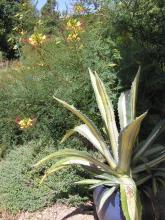
High Plains Gardening
The gardening website of the Texas High Plains Region

Agaves are striking and architectural Southwest native plants and are included in a group of plants I term Southwest evergreens. They are unusual in that at maturity, they only flower once, and then die. for this reason, some classify them as multiannual, rather than perennial. However, as they common name suggests, it takes many years before they flower. Leaves of the Agave are arranged in a spiral beginning from a near invisible stem, forming a rosette.Agaves vary in size from 4-6 inches to larger than man-size. In the Texas Panhandle, the largest cold hardy agave is Agave havardiana, growing to a size of 24-30 tall and wide. Agaves propagate by send out pups. Agaves require good drainage and do not like to be watered much in the winter. Keep snow from piling on them.
This is a starting point of Agaves to plant in ground for wintering over outside and are within the range of the average low temperature for the Texas Panhandle. I compiled this list in February, 2012.
Agave cerulata, 10° (A), Have not tried it.
A. havardiana, -10°, (A), (C), (D) Yes, has wintered over for 10+ years.
A. lechuguilla, 0°, (A), (D) Yes, wintered over 10+ years so far.
A. lophantha, 10°, (A), (B). Have not tried it, but doubt its cold hardy.
A. montana, 10°, (B). I have not tried it.
A. murpheyi, 10°, (A), Have not tried it.
A. neomexicana, -20°, (A), (C), (D), Yes, wintered over 10+ years.
A. palmeri, 10°, (A) Have not tried it.
A. parryi, -20°, (A), (D). Yes, wintered over 10+ years.
A. parryi var truncata, 15°, (A), (D). Tried 3 of them and they all froze.
A. parviflora, 10°, (A). Have not tried it.
A. salmiana, 5°, (A). Have not tried it.
A. scabra, 10°, (A), (B), (D). Wintered over 1 year good. Second year froze back to the roots but re-grew. The third year it did not emerge. Keep snow off of it to prevent dieback, perhaps.
A. schottii, 10°, (A), (E). I have not tried it.
A. toumeyana var. 'Bella', 10° (A), (C). Flowered and died after flowering first year I bought it. Needs a longer trial.
A. utahensis, all varieties, 0 – 10°, (A) Have not tried them yet.
A. victoria-reginae, 10° (A), (B), (E). Planted in a protected location facing south 2 winters now. They winter over in Albuquerque. Consider them marginal in Amarillo.
In researching the cold hardiness of Agaves, the lowest range of temperatures given often varies. This is due, in part at least, to soil texture, organic content and winter moisture. You will achieve good results with soils that have very good drainage and low organic content. One final reminder – no winter irrigation. Low temperatures give are from the following sources:
Xeric, native plant, habitat and high desert gardens. Rock gardens, succulent and cactus gardens. As a focal point or in containers. A large non-cold hardy agave will make a stunning focal point in a container. A southwest evergreen plant that prides stunning architectural interest throughout the year, especially in winter.
No maintenance.